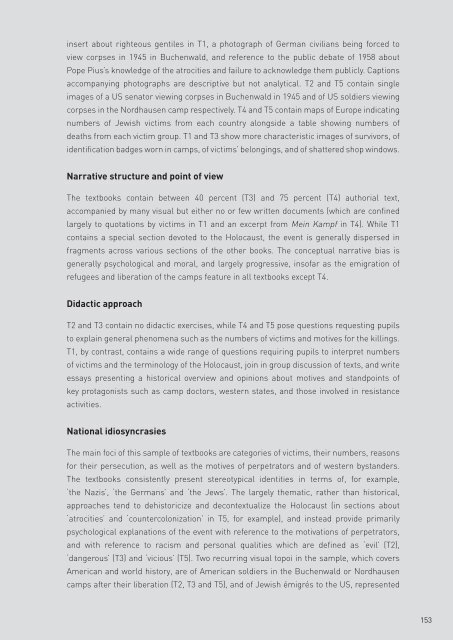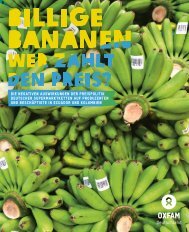228776e
228776e
228776e
You also want an ePaper? Increase the reach of your titles
YUMPU automatically turns print PDFs into web optimized ePapers that Google loves.
insert about righteous gentiles in T1, a photograph of German civilians being forced to<br />
view corpses in 1945 in Buchenwald, and reference to the public debate of 1958 about<br />
Pope Pius’s knowledge of the atrocities and failure to acknowledge them publicly. Captions<br />
accompanying photographs are descriptive but not analytical. T2 and T5 contain single<br />
images of a US senator viewing corpses in Buchenwald in 1945 and of US soldiers viewing<br />
corpses in the Nordhausen camp respectively. T4 and T5 contain maps of Europe indicating<br />
numbers of Jewish victims from each country alongside a table showing numbers of<br />
deaths from each victim group. T1 and T3 show more characteristic images of survivors, of<br />
identification badges worn in camps, of victims’ belongings, and of shattered shop windows.<br />
Narrative structure and point of view<br />
The textbooks contain between 40 percent (T3) and 75 percent (T4) authorial text,<br />
accompanied by many visual but either no or few written documents (which are confined<br />
largely to quotations by victims in T1 and an excerpt from Mein Kampf in T4). While T1<br />
contains a special section devoted to the Holocaust, the event is generally dispersed in<br />
fragments across various sections of the other books. The conceptual narrative bias is<br />
generally psychological and moral, and largely progressive, insofar as the emigration of<br />
refugees and liberation of the camps feature in all textbooks except T4.<br />
Didactic approach<br />
T2 and T3 contain no didactic exercises, while T4 and T5 pose questions requesting pupils<br />
to explain general phenomena such as the numbers of victims and motives for the killings.<br />
T1, by contrast, contains a wide range of questions requiring pupils to interpret numbers<br />
of victims and the terminology of the Holocaust, join in group discussion of texts, and write<br />
essays presenting a historical overview and opinions about motives and standpoints of<br />
key protagonists such as camp doctors, western states, and those involved in resistance<br />
activities.<br />
National idiosyncrasies<br />
The main foci of this sample of textbooks are categories of victims, their numbers, reasons<br />
for their persecution, as well as the motives of perpetrators and of western bystanders.<br />
The textbooks consistently present stereotypical identities in terms of, for example,<br />
‘the Nazis’, ‘the Germans’ and ‘the Jews’. The largely thematic, rather than historical,<br />
approaches tend to dehistoricize and decontextualize the Holocaust (in sections about<br />
‘atrocities’ and ‘countercolonization’ in T5, for example), and instead provide primarily<br />
psychological explanations of the event with reference to the motivations of perpetrators,<br />
and with reference to racism and personal qualities which are defined as ‘evil’ (T2),<br />
‘dangerous’ (T3) and ‘vicious’ (T5). Two recurring visual topoi in the sample, which covers<br />
American and world history, are of American soldiers in the Buchenwald or Nordhausen<br />
camps after their liberation (T2, T3 and T5), and of Jewish émigrés to the US, represented<br />
153




